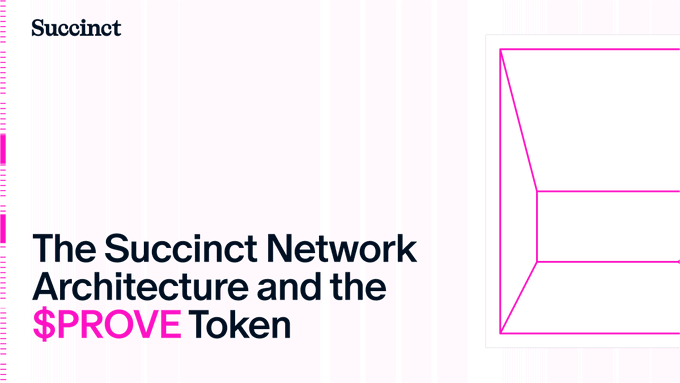Succinct’s Core Positioning and Technical Breakthrough
Succinct is a ZK (zero-knowledge proof) infrastructure project led by Paradigm, aiming to provide efficient, low-cost ZK proof services for blockchains and cross-chain applications via a decentralized network. Its core product, SP1 zkVM, is currently the fastest zero-knowledge virtual machine, supports Rust-based development, is compatible with Ethereum smart contracts, and boosts ZK proof generation speed by 28 times while reducing costs to one-tenth of traditional solutions.

This Token Insights article delves into Succinct’s ZK proof network architecture, the PROVE token economic model, and the challenges it faces.
On May 20, 2025, Succinct announced its native token PROVE and revealed its network architecture: the Succinct Prover Network. This network combines off-chain auctions with on-chain settlement using a vApp architecture. It uses a distributed prover cluster to generate high-performance proofs, targeting throughput of tens of thousands of proof requests per second. The network is currently in Testnet Phase 2 and is expected to upgrade to Stage 2.5 shortly to pave the way for mainnet launch.
Technical Architecture and Innovation Highlights
SP1 zkVM: Balancing Performance and Versatility
SP1 zkVM uses a precompile mechanism to optimize common cryptographic operations (e.g., Keccak, SHA256), allowing developers to reuse existing Rust libraries and improving development efficiency by 100x. The latest version, SP1 Turbo, can verify Ethereum mainnet blocks in just 40 seconds on a GPU cluster at a cost of only a few cents. It is already adopted by major projects such as Polygon and Celestia.
Hybrid Architecture Design: Off-Chain Efficiency and On-Chain Security
-
Off-Chain Auction Service: Dynamically matches proof requests with distributed compute resources, supporting real-time bidding and load balancing;
-
On-Chain Settlement Contract: Manages user funds and verifies proof validity to ensure trustless interactions.
This architecture balances high performance and decentralization, reducing single proof generation time to 1–5 seconds, with costs below $0.10.
Cross-Chain Interoperability and Privacy Enhancements
Succinct achieves trustless communication between Ethereum and other chains via the Telepathy protocol, supporting ZK verification for use cases like cross-chain bridges and oracles. Future plans include integrating ZKML (Zero-Knowledge Machine Learning) modules to enhance privacy-preserving computation capabilities.
PROVE Token Economic Model and Market Dynamics
Token Distribution and Core Functions
-
Total Supply: 1 billion PROVE tokens
-
Allocation: 50% community incentives, 42% investors & team, 8% foundation reserve
Utility
- Gas Payment: ZK proof generation consumes PROVE with dynamic fee adjustment;
- Staking Incentives: Validators staking tokens can earn 12%-18% APY;
- Governance Voting: Determine parameters like new chain support and fee distribution.
Potential Risks and Market Strategy
-
Sell Pressure Risk: Private-sale tokens unlock gradually from Q3 2025, with daily emissions accounting for 0.8% of circulating supply;
-
Ecosystem Dependency: 80% of current transaction volume depends on testnet gaming scenarios. Expansion into enterprise-grade applications is needed to increase utility.
Investors can track real-time price and staking metrics via the JuCoin market page.
Ecosystem Expansion and Industry Competition
Partners and Use Cases
-
Polygon, Celestia: Use SP1 zkVM to build ZK Rollups and cross-chain bridges, securing over $1 billion in on-chain assets;
-
Avail, Taiko: Integrate Succinct protocol for data availability validation and private transactions.
Competitor Analysis
-
Bittensor (TAO): Holds 70% of ZK sector market cap but focuses on AI models rather than infrastructure;
-
Aleo, Risc Zero: Focused on privacy computing but lack cross-chain compatibility.
Regulatory Challenges
The U.S. SEC is reviewing the “securities nature” of ZK agents, potentially limiting PROVE’s circulation.
The EU’s MiCA regulation requires cross-chain bridges to comply with anti-money laundering standards.
Outlook: The Vision for Decentralized ZK Proof Networks
Technology Roadmap
-
Q4 2025: Launch privacy transaction module based on ZK proofs to hide transaction amounts and addresses;
-
2026: Launch decentralized sequencer network to reduce single points of failure.
Market Expansion Plan
-
Developer Incentives: $150 million fund to support DeFi, GameFi, and ZKML applications;
-
Asia-Pacific Strategy: Partnering with RedotPay to launch compliant fiat on/off-ramps, focusing on Southeast Asia.
If Succinct can balance performance and decentralization, its “Proof-as-a-Service” model may redefine the valuation logic of ZK computing power. When verification becomes the oxygen of the digital world, the decentralized proof network becomes its respiratory system.




